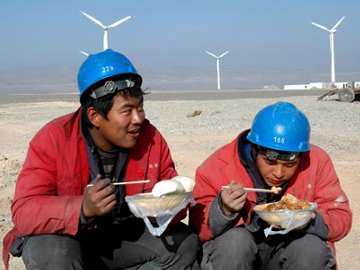
Beijing – After a rash of wind turbine malfunctions, China is to “revise” (ie raise) its standards for wind turbine production.
China’s wind power capacity surpassed that of the U.S. in 2009 and the country is planning to further raise the proportion of renewables in the nation’s fast-growing energy consumption, according to Shi Lishan, deputy director of the New and Renewable Energy Department of the National Energy Administration (NEA).
Chinese wind power has long been half the price of Western competitors, but also less reliable. However, even the best Western small turbines are relatively unreliable, so if China raises its standards, it will become competitive.
China currently has more than 2 billion kilowatts of inland wind power resources and more than 500 million kilowatts offshore.
However “a rising trend of wind turbine breakdowns has been witnessed since 2010,” says a State report. There were 193 accidents in wind farms in the first 8 months of 2011, according to the report released last week by the State Electricity Regulatory Commission (SERC). It also announced decision to double the solar subsidy forthwith.The accidents reveal the conflict between technology standards in the rushed development of wind power, as well as the technical problems of bringing wind power onto the national grid, according to an analyst familiar with the situation.
China is to redirect wind power development towards product quality, instead of speed and installed capacity. In late 2011 the NEA set stricter access thresholds for wind power projects, and higher national technology standards for wind power access to the grid. Wind turbine projects with a capacity less than 50,000 kw must now also apply to NEA, instead of getting approval from local governments.
Meanwhile, the SERC launched a national inspection of 360 wind farms with access to the grid and 80 under-construction wind farms, 50 percent of which have completed security maintenance.
In a threat to Western competitors, China is to formulate subsidies for wind power prices and “favoring policies for wind power’s local utilization in a bid to achieve a sustainable development of wind power,” according to the SERC report.
The subsidies for frequency and peak modulated wind power sources are part of a bid to formulate compensation standards for grid connected wind power systems and facilitate the wholesale purchase of wind generated power, according to the report.
In a boost to the Smart Grid in China, State companies will construct more power transmission lines and other infrastructure to coordinate the construction of wind farms on the grid, according to the SERC report.
Meanwhile, the State Grid Corp, China’s largest power grid operator, also plans to invest some 1.6 trillion yuan for smart grid system construction in China in 2011-2015, Liu Zhenya, general manager of the company said at the Smart Grid World Forum 2011 in late September.
By the end of 2015, the smart grid system will give access to 90 million kilowatts of wind power and 8 million kilowatts of solar electric energy, Liu claimed.
The plan for China’s renewable energy industry for 2011-2015 will increase the solar energy installed capacity to 15 million kilowatts by 2015.
At the same time, China has doubled the subsidy for on-grid price of electricity generated from renewable energy sources to 0.008 yuan/kilowatt hour (kwh) from current level of 0.004 yuan/kwh starting from December 1.
The higher target for solar capacity and the increased subsidy are evidence of China’s determination to subsidise its solar PV industry over the next five years.
China’s total solar power installed capacity is 3 million kilowatts up from just 800,000 kilowatts in 2010.
